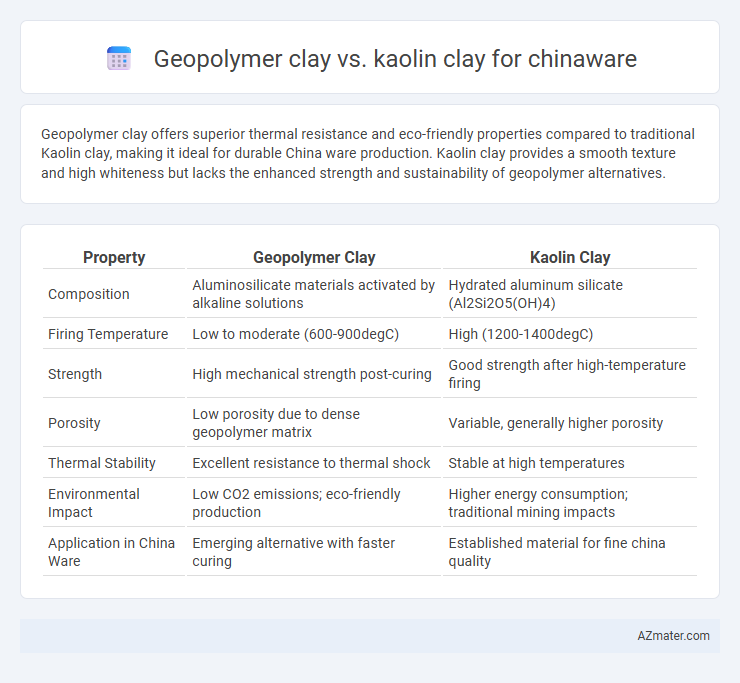Geopolymer clay offers superior thermal resistance and eco-friendly properties compared to traditional Kaolin clay, making it ideal for durable China ware production. Kaolin clay provides a smooth texture and high whiteness but lacks the enhanced strength and sustainability of geopolymer alternatives.
Table of Comparison
| Property | Geopolymer Clay | Kaolin Clay |
|---|---|---|
| Composition | Aluminosilicate materials activated by alkaline solutions | Hydrated aluminum silicate (Al2Si2O5(OH)4) |
| Firing Temperature | Low to moderate (600-900degC) | High (1200-1400degC) |
| Strength | High mechanical strength post-curing | Good strength after high-temperature firing |
| Porosity | Low porosity due to dense geopolymer matrix | Variable, generally higher porosity |
| Thermal Stability | Excellent resistance to thermal shock | Stable at high temperatures |
| Environmental Impact | Low CO2 emissions; eco-friendly production | Higher energy consumption; traditional mining impacts |
| Application in China Ware | Emerging alternative with faster curing | Established material for fine china quality |
Introduction to Geopolymer Clay and Kaolin Clay
Geopolymer clay is an innovative material formed by activating aluminosilicate powders with alkaline solutions, offering enhanced thermal resistance and durability compared to traditional clays. Kaolin clay, also known as china clay, is a naturally occurring, fine-grained mineral primarily composed of kaolinite, essential for producing porcelain and fine china due to its purity and plasticity. Both materials play crucial roles in ceramic manufacturing, with geopolymer clay providing a sustainable alternative and kaolin clay maintaining its status for high-quality, whitish china ware.
Historical Background of China Ware Production
Geopolymer clay and kaolin clay hold distinct historical significance in China ware production, with kaolin clay being the traditional primary material since the Tang Dynasty, renowned for its purity and fine particle size that enables the creation of delicate porcelain. Geopolymer clay represents a modern innovation, leveraging aluminosilicate-rich raw materials to produce more environmentally sustainable ceramics with enhanced thermal and mechanical properties. The evolution from kaolin to geopolymer clay marks a shift in Chinese ceramics, balancing centuries-old artisanal techniques with advanced material science for improved durability and environmental impact.
Composition and Properties of Kaolin Clay
Kaolin clay, primarily composed of the mineral kaolinite (Al2Si2O5(OH)4), features a fine particle size and high plasticity, making it essential for China ware production due to its whiteness, translucency, and strength after firing. Its low firing temperature and minimal impurities contribute to the smooth surface and durability characteristic of traditional porcelain. In contrast, geopolymer clay incorporates aluminosilicate materials activated by alkaline solutions, offering enhanced thermal resistance and chemical stability but lacking the pure, fine texture and translucency of kaolin-based China ware.
Geopolymer Clay: Formation and Characteristics
Geopolymer clay forms through the chemical reaction of aluminosilicate materials with alkaline activators, creating a strong, durable matrix ideal for China ware production. This clay type exhibits enhanced thermal resistance and mechanical strength compared to traditional kaolin clay, making it suitable for high-temperature applications. Its low shrinkage and high resistance to cracking improve the structural integrity of finished ceramics, providing advantages over kaolin-based China ware.
Processing Techniques for Both Clays
Geopolymer clay involves alkali activation of alumino-silicate materials, requiring precise mixing of metakaolin with alkaline solutions followed by curing at moderate temperatures to develop a robust ceramic matrix. Kaolin clay undergoes traditional processing steps, including refining, blending with fluxes, shaping, and high-temperature firing to achieve the characteristic whiteness and translucency of China ware. Advanced control of moisture content and particle size distribution is critical in both processing techniques to optimize plasticity, drying behavior, and final mechanical properties of the ceramic body.
Mechanical Strength Comparison
Geopolymer clay exhibits superior mechanical strength compared to kaolin clay when used in china ware due to its enhanced bonding properties and greater resistance to thermal shock. The compressive strength of geopolymer clay typically exceeds 50 MPa, surpassing the 30-40 MPa range commonly observed in kaolin-based ceramics. This increased mechanical performance results in improved durability and longevity of china ware made from geopolymer clay.
Firing Temperature and Energy Efficiency
Geopolymer clay requires significantly lower firing temperatures, typically around 1000degC, compared to Kaolin clay's 1200-1400degC range for China ware production. This reduction in firing temperature translates to enhanced energy efficiency, reducing fuel consumption and lowering greenhouse gas emissions during the kiln process. Consequently, geopolymer clay offers an environmentally sustainable alternative for manufacturing porcelain with comparable strength and durability.
Environmental Impact and Sustainability
Geopolymer clay offers a significantly lower carbon footprint compared to traditional kaolin clay as it utilizes industrial by-products like fly ash, reducing reliance on virgin natural resources. Kaolin clay extraction causes substantial environmental degradation through strip mining, leading to habitat loss and soil erosion, whereas geopolymer formulations reduce waste and energy consumption by requiring lower firing temperatures. Sustainable production of China ware increasingly favors geopolymer clay due to its recyclability, minimal toxic emissions, and potential for circular economy integration.
Application Suitability in China Ware
Geopolymer clay offers superior thermal resistance and strength, making it highly suitable for high-temperature China ware applications requiring durability and minimal shrinkage. Kaolin clay, prized for its whiteness and plasticity, remains the preferred choice for traditional fine China ware due to its excellent workability and smooth finish. The application suitability depends on the desired balance between mechanical strength and aesthetic qualities in the final China ware product.
Future Trends: Innovations and Market Potential
Geopolymer clay exhibits significant future potential in China ware production due to its eco-friendly composition and superior strength compared to traditional Kaolin clay. Innovations in geopolymer formulations enhance thermal resistance and reduce firing energy consumption, aligning with sustainable manufacturing trends. Growing market demand for environmentally responsible ceramics positions geopolymer clay as a transformative material in the ceramics industry.

Infographic: Geopolymer clay vs Kaolin clay for China ware
 azmater.com
azmater.com